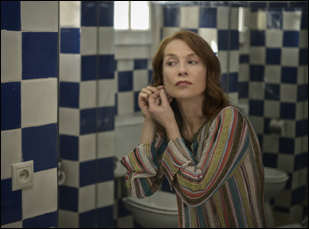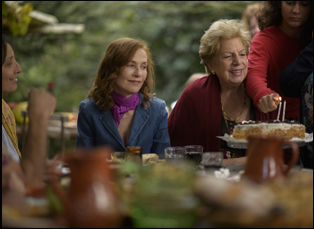It stands to reason that as gracefully as life flows throughout the films of Ira Sachs, it is natural that the spectre of death should too as it does in “Frankie,” the latest from the director of “Love is Strange” and “Little Men.” Starring Isabelle Huppert as the titular character, a well-regarded thespian who has learned relatively recently of her terminal diagnosis, she has gathered her family in Portugal for a final get-together with few knowing of her health status besides her husband Jimmy (Brendan Gleeson), and even without this bit of bad news, the vacation is hardly relaxing as her loved ones seem to have little love lost between them. Her step-daughter Sylvia (Vinette Robinson) is edging her way out of her marriage to Ian (Ariyon Bakare), waiting for the right moment to tell him she’s leaving, and their teenage daughter Maya (Sennia Nanua) has left for the beach for the day, knowing her mother’s intentions, and her son Paul (Jeremie Renier) recently left his job and wonders whether he should reunite with an ex, leading Frankie to invite her favorite artistic collaborator Ilene (Marisa Tomei) as a potential match for him to bring some stability to his life, unaware that Ilene has a boyfriend Gary (Greg Kinnear) that she asked to join her since he’s coming off shooting second unit photography on the “new Star Wars” nearby in Spain.
Despite the secret reason for the gathering, few tears are shed in “Frankie” — its lead insists that if others cry, she will too once word gets out — yet like much of Sachs’ filmography, it is extraordinarily moving as the filmmaker, once again working with co-writer Mauricio Zacharias, not only finds a great deal to consider as Frankie attempts to get her affairs in order and ruminates on what life will be like for those she leaves behind after she’s gone, but brilliantly constructs a sly narrative in which every stage of a relationship as it relates to time can be explored, from the burgeoning infatuation of Maya upon meeting a boy on the shoreline to Jimmy learning to let go of Frankie as she nears the end. Set in the mountains of Sintra, it feels that every small step the family takes towards better understanding each other as well as themselves in their specific wants and needs builds to greater and greater heights, and filled with warmth and disarming wit, “Frankie” follows its lead in not shrinking from an intimidating subject, engaging with all the potential sorrow that death can bring with impressive vitality.
Following its premiere at the Cannes Film Festival earlier this year, the film arrives in American theaters this week and during a recent visit to Los Angeles, Sachs spoke about how he sees his stories as part of a continuum, both in cinematic and generational terms, as well as how he was inspired by the scenery in Portugal and how his own life is reflected by the films he makes.
About ten years ago, I saw a film by Satyajit Ray called “Kanchenjungha,” which was made in 1962 — the first color film by Ray — and it’s a film about a family on a vacation in the Himalayan mountaintop. It takes place in the course of one day, there’s nine stories and it’s really about the family and the context of nature and the surroundings. I was very moved by the film and it was really stuck in my head as a nice structure and form for a story and then when I met Isabelle [Huppert] soon after “Love is Strange” — she had written me about that film and we started talking — I realized this mountain film would be a really good project for us to work on because we would both be somewhere different than our home. I couldn’t really imagine making a film with Isabelle Huppert in France – I wouldn’t be the expert. But somehow a film about travel and being outside of your normal surroundings felt very comfortable for me. And then the particular story of this film is really personally connected to my experience in the last five to seven years around illness and being closer to it than I had been previously and discovering it was such a different planet than I imagined.
It happened that we were both at the same screening of Karim Ainouz’s “The Invisible Life of Euridice Gusmao” at the Toronto Film Fest, and I was fascinated to hear you ask a question after the screening about how much he felt he could lean into melodrama with such emotional subject matter. Is that something you’re concerned about yourself with something like this?
I think we’re playing with high drama and we’re also playing with high comedy and high farce, so there’s all these different things, but maybe in a semi-muted way, I’m trying to keep it in the range of the real. We were watching “Rules of the Game” in thinking about this movie and how sometimes by pushing things into a theatrical place, something else happens for the audience that’s kind of surprising and exciting and extreme. So there were [parts of the story] where you wanted these moments that had sharp edges.
There is a sense of balance [where] you need to give the audience enough, but not too much. I want the audience to feel like they have to work a little bit to get intimate, but when they do, the intimacy is strong. It’s like a relationship – it doesn’t happen in a minute. And it helps to have really good actors because they’re able to make real stuff that is dramatic and I encourage my actors to find the most authentic relationship to the material that is closest to themselves and I think that gives a realism to the work. I also try and surround them with a world that is almost like a documentary. They don’t have to imagine very much as actors. For example, a scene with family celebrating a birthday – that was was 35 members of the same [real] family who already knew each other really well, so for Isabelle Huppert to enter that world, she didn’t really have to think. There was nothing false about the relationships she was navigating and I think that helps the actor.

That’s actually a good parallel and it was a family I liked on the first meeting, not dissimilar to that family in the birthday party. I felt more comfortable than Isabelle did. I felt there was also a shared love for the art cinema, so in a way, [while] there were different countries [involved], there was a shared education through the movies, so we could very fluidly talk about Fassbender and Akerman and Joao Pedro Rodrigues and Portuguese cinema and Ozu, which is like a language of love. It’s international.
Was an international production, where you were pulling actors from all over the world, an exciting prospect?
I’ve always done that to some extent, meaning I’ve worked with a lot of people who were not American. I’ve made a film with a Vietnamese lead actor, a Russian lead actor, a Danish lead actor, a Chilean lead actor, and I think that mirrors to a great extent my own family. My husband’s from Ecuador, my co-writer’s from Brazil, my script supervisor’s Romanian, so I think that is the world that I live in, which is not centered on America.
Your co-writer Mauricio has Portuguese roots, but how did you end up setting this there?
He suggested we consider Sintra as a location and I felt that Portugal, in general, was a place for audiences that didn’t come with too many advanced expectations. For better or worse, there’s a cultural innocence to that country, so I felt there was a pretty blank slate that I could work with, and though this film is really not about Portugal, it is about that particular landscape. I went to visit Sintra with Mauricio maybe a year before we finished the script and we spent a lot of time there, [so I knew] the location and my emotional experience of those spaces and we could write very specifically for particular spots, particularly that last vantage point on the top of this mountain where I felt was a good direction for the film to go.
Well, the weather was the weather. You’re shooting a film set in one day over about six weeks, and it’s a microclimate, so it’s changing by the hour. We had hurricanes, forest fires, and tremendous rain storms and what I quickly understood was I needed to accept the weather for what it was and not fight it, and in some ways, you could say accepting nature is the theme of the film, so it worked. For example, the scene where Greg Kinnear and Isabelle Huppert first meet, that scene was planned to be outdoors in the sunlight and then there was a rainstorm and so we went to find cover as a production as they do as characters and it works for the film because it gives these magical transformations of mood.
It seemed like you were able to work with diegetic sound in a way I can’t remember before with the environment. Was that an exciting opportunity for you?
There was a way when I began to work on sound that there was both something natural and also something magical about the feeling of space, and the characters are never isolated from the air and the land around them. That was something that I wanted the audience to feel when they watch the movie.

That came in the course of developing the stories and thinking about the characters and when you’re talking about so many stories – nine different stories, you want to give enough that the audience can imagine the world beyond the film in a full way, so that’s a delicate balance. Ever since I saw a lot of Ozu movies and really started working in a way under the influence of Ozu, I find that I can’t think of character without thinking about generations and that characters are always defined by the unspoken conversation of those who come before and those who come after, so this idea of parallels and differences based on somebody’s age and perspective is central to the film.
Was there anything that happened that you weren’t anticipating, but it’s in the film and you really like about it?
Every day something happened that I wasn’t expecting and usually, it has something to do with what an actor does. I don’t rehearse before I start shooting, so I haven’t heard the lines and neither have the actors from each other, so there is this kind of unexpected moment where anything can happen emotionally between two people and I get a great pleasure in watching performance and watching what actors can do with dialogue. It’s almost like watching an acrobat and in this case, I was shooting in a style where there’s not a lot of cutting, so there is a lot of space for the actor to perform and they are the ones – not the edit – that’s getting us from one emotion to the next. There’s a lot of surprise and pleasure in that.
“Frankie” opens on October 25th in Los Angeles at the Laemmle Royal and New York at the Angelika Film Center.






